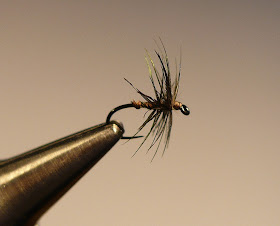An Ephemera Danica Imitation
This is a pattern that became known and used a lot in the 80'ties here in Sweden to represent Ephemera Danica (the pattern can still be found in fly fishing stores and is most probably still being used) and as you can see this is not a tiny fly. The tying description is as follows:
Hook: Mustad 94833 size #12
Thread: Light Brown
Tail and abdomen: Light golden badger hackle reversed
and leaving 2 barbs on each side as
tails (It's a little hard to see the
extended body well on this picture
but I think it's imaginable)
Thorax: Fly Rite 22
Wings: Hen saddle colored olive
Hackle: Grizzle or badger
This tying description is taken from the book "Flugbindning på mitt sätt" (Fly tying my way) by Lennart Bergqvist (A very good manual for fly tying of a lot of the insects found in Sweden).
Anyway I've experienced that flexibility is a must if you want to be able to play a trout or grayling everywhere they are present and at all times possible. When there is a good hatch of Ephemera Danica (Green Drake) not even the smallest of fish won't give any attention to tiny flies (with some exceptions naturally). This is The largest of the mayflies found in Sweden. It's appearance makes it possible to come in contact with the biggest of trout even in small streams. Scouting your favorite streams for the places where big trout have taken their position will pay off when the hatch begins.
So why opening this subject now, a pretty long time before it will appear (here normally in mid June or the beginning of July)? Well in some warmer places than here, sometimes it will appear in May and that's not so far away. Furthermore it might be good to make some preparations before they start hatching. Scouting out your favorite streams for big trout as mentioned before. There are many nice patterns that imitate this big mayfly now. I guess that the preferences are quite different when it comes to which fly to use. Many tips and patterns can be seen watching the video "Mayfly Madness". This video was made by Johan Klingberg and Ulf Börjesson. They scouted a lot of streams during three seasons making this video. Here comes two links to trailers of that video:
http://www.youtube.com/watch?v=Jm3OZtnyuxE&feature=endscreen
http://www.youtube.com/watch?v=ZpntQRz7Bq0
Here (in the second trailer) you can see a wonderful trout being caught and released in a pretty small stream. Well that kind of rounds off this post so until the next one ...
Kind greetings,
Mats Olsson
Hook: Mustad 94833 size #12
Thread: Light Brown
Tail and abdomen: Light golden badger hackle reversed
and leaving 2 barbs on each side as
tails (It's a little hard to see the
extended body well on this picture
but I think it's imaginable)
Thorax: Fly Rite 22
Wings: Hen saddle colored olive
Hackle: Grizzle or badger
This tying description is taken from the book "Flugbindning på mitt sätt" (Fly tying my way) by Lennart Bergqvist (A very good manual for fly tying of a lot of the insects found in Sweden).
Anyway I've experienced that flexibility is a must if you want to be able to play a trout or grayling everywhere they are present and at all times possible. When there is a good hatch of Ephemera Danica (Green Drake) not even the smallest of fish won't give any attention to tiny flies (with some exceptions naturally). This is The largest of the mayflies found in Sweden. It's appearance makes it possible to come in contact with the biggest of trout even in small streams. Scouting your favorite streams for the places where big trout have taken their position will pay off when the hatch begins.
So why opening this subject now, a pretty long time before it will appear (here normally in mid June or the beginning of July)? Well in some warmer places than here, sometimes it will appear in May and that's not so far away. Furthermore it might be good to make some preparations before they start hatching. Scouting out your favorite streams for big trout as mentioned before. There are many nice patterns that imitate this big mayfly now. I guess that the preferences are quite different when it comes to which fly to use. Many tips and patterns can be seen watching the video "Mayfly Madness". This video was made by Johan Klingberg and Ulf Börjesson. They scouted a lot of streams during three seasons making this video. Here comes two links to trailers of that video:
http://www.youtube.com/watch?v=Jm3OZtnyuxE&feature=endscreen
http://www.youtube.com/watch?v=ZpntQRz7Bq0
Here (in the second trailer) you can see a wonderful trout being caught and released in a pretty small stream. Well that kind of rounds off this post so until the next one ...
Kind greetings,
Mats Olsson

